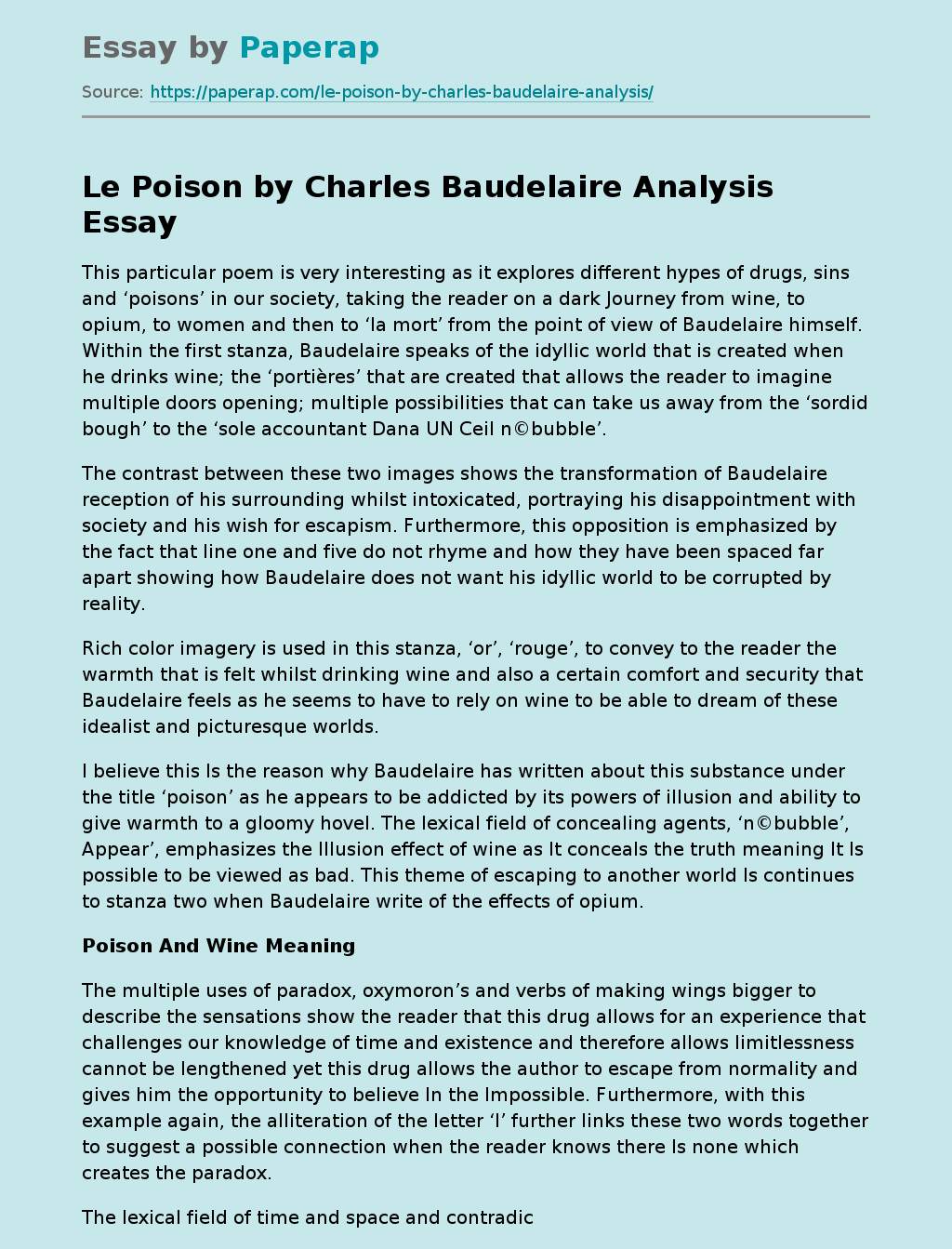This particular poem is very interesting as it explores different hypes of drugs, sins and ‘poisons’ in our society, taking the reader on a dark Journey from wine, to opium, to women and then to ‘la mort’ from the point of view of Baudelaire himself. Within the first stanza, Baudelaire speaks of the idyllic world that is created when he drinks wine; the ‘portières’ that are created that allows the reader to imagine multiple doors opening; multiple possibilities that can take us away from the ‘sordid bough’ to the ‘sole accountant Dana UN Ceil n©bubble’.
The contrast between these two images shows the transformation of Baudelaire reception of his surrounding whilst intoxicated, portraying his disappointment with society and his wish for escapism. Furthermore, this opposition is emphasized by the fact that line one and five do not rhyme and how they have been spaced far apart showing how Baudelaire does not want his idyllic world to be corrupted by reality.
Rich color imagery is used in this stanza, ‘or’, ‘rouge’, to convey to the reader the warmth that is felt whilst drinking wine and also a certain comfort and security that Baudelaire feels as he seems to have to rely on wine to be able to dream of these idealist and picturesque worlds.
I believe this Is the reason why Baudelaire has written about this substance under the title ‘poison’ as he appears to be addicted by its powers of illusion and ability to give warmth to a gloomy hovel.
The lexical field of concealing agents, ‘n©bubble’, Appear’, emphasizes the Illusion effect of wine as It conceals the truth meaning It Is possible to be viewed as bad. This theme of escaping to another world Is continues to stanza two when Baudelaire write of the effects of opium.
Poison And Wine Meaning
The multiple uses of paradox, oxymoron’s and verbs of making wings bigger to describe the sensations show the reader that this drug allows for an experience that challenges our knowledge of time and existence and therefore allows limitlessness cannot be lengthened yet this drug allows the author to escape from normality and gives him the opportunity to believe In the Impossible. Furthermore, with this example again, the alliteration of the letter ‘l’ further links these two words together to suggest a possible connection when the reader knows there Is none which creates the paradox.
The lexical field of time and space and contradictions adds to the surreal nature of these descriptions In order to emphasis how almost. I believe Baudelaire describes the drug In this way to make the reader believe that this method of escapism Is very successful and that It can give the consumer the ability to believe that anything Is possible, leaving and challenging our naiads AT tongue I en poets use AT applets Ana contrasting lexes links to ten uncommon, alternating meter of alexandrine and hypermarket showing how opium opposes reality.
Throughout this stanza, we are not sure whether Baudelaire enjoys or fears this drug as there are many contrasts which could show his uncertainty, but he uses the word ‘morons’ to describe the pleasures that are created which is an oxymoron, again making his feeling ambiguous to the reader. Throughout the last two stanzas, the poem’s theme changes to a woman, the third and arguably the worst poison that Baudelaire describes. There is a semantic field of liquids within this section, linking to the softness and tenderness of women yet also linking to the soon that Baudelaire describes.
These two images that associate with the lexis of liquids are directly linked in the line ‘el poison quiz d©coulee/ De test yes, De test yes averts’ as often we define tears to be something feminine yet the poet contradicts this social sign in order to portray this woman as something evil and dangerous. Another motif that occurs throughout this poem is sins Real vs. Surreal It is commonly known to many people that Charles Baudelaire often wrote his poems intoxicated on either wine or opium, which could be reflected in the uncommon alexandrine and hypothetical composition.
Firstly, a prominent theme that can be seen throughout this poem is the theme of escapism as the poet explains the sensations and feelings that come with wine, opium and women in a way that expresses how he uses these to escape reality. Finally, the opening of this poem, an image of melancholy, reflects the ending of death showing that however hard Baudelaire tries to escape the ‘sordid bough’ with wine, opium and drugs, he continually fails and ends
Le Poison by Charles Baudelaire Analysis. (2019, Dec 05). Retrieved from https://paperap.com/le-poison-by-charles-baudelaire-analysis/

